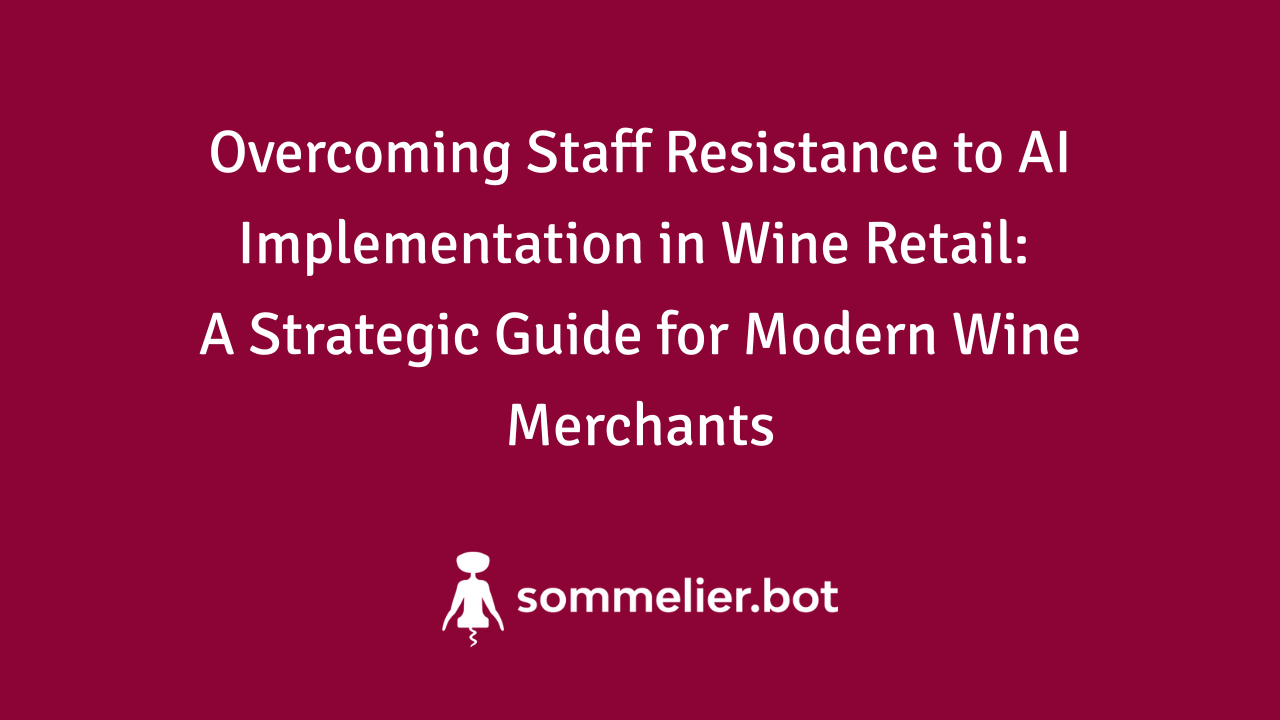For medium to large-sized brick-and-mortar and online wine merchants, the integration of artificial intelligence represents both an unprecedented opportunity and a formidable challenge. While AI promises to revolutionize customer experiences, streamline operations, and bridge knowledge gaps, the path to successful implementation often encounters its most significant obstacle within your own walls: staff resistance.
This resistance isn’t born from ignorance or incompetence – it stems from legitimate concerns about job security, technological complexity, and the fear of losing the very heart of what they deliver daily: wine service. Understanding and addressing these concerns strategically can transform your team from skeptics into AI advocates, ultimately driving both in-store traffic and online engagement while maintaining the personalized service your customers expect.
Understanding the Root Causes of Staff Resistance in Wine Retail
The wine industry has always been relationship-driven, with knowledgeable staff serving as the cornerstone of customer trust and loyalty. When AI enters the equation, experienced sommeliers and retail staff can initially perceive it as a threat to their expertise and value proposition. This perception is particularly pronounced in establishments where staff pride themselves on curated selections and personalized recommendations. The more established and prestigious the wine place is, the less inclined its employees are to adopt AI as a sales and knowledge companion.
Three primary concerns dominate staff resistance: fear of job displacement, skepticism about AI’s ability to match human wine knowledge, and concern that technology will create barriers or distance between staff and customers. These concerns are amplified in multi-location operations where consistent implementation becomes more complex and resource-intensive. In this context, concerns over AI increasing customer volatility and reducing store visits are heartfelt.
The challenge intensifies when considering the knowledge gap between seasoned wine professionals and newer staff members. The latter being tech-prone may find AI can help store browsing customers by providing instant access to detailed wine information and pairing suggestions, whereas experienced staff may view this as diminishing their years of acquired expertise and experience, and favoring abandonment or even distanciation with their loyal clientele.
The Strategic Imperative: Why AI Integration Cannot Be Delayed
Today’s wine consumers, particularly younger demographics, expect seamless digital experiences that complement in-person interactions. They research wines online before visiting stores, expect knowledgeable recommendations regardless of which staff member they encounter, and value efficiency alongside expertise. “The future of AI in the wine and spirits industry” is not a distant possibility – it’s today’s competitive reality.
Medium to large-sized wine merchants face unique pressures in this landscape. Unlike boutique wine shops that can rely solely on the owner’s expertise, larger operations must ensure consistent knowledge and service quality across multiple locations, and must guarantee staff cohesion. This scalability challenge makes AI not just beneficial but essential for maintaining a competitive advantage.
Furthermore, the complexity of modern wine retail operations – managing inventory across multiple channels, personalizing recommendations for diverse customer bases, and maintaining robust online presence – requires technological solutions that can process vast amounts of data and provide actionable insights in real-time.
A Framework for Overcoming Staff Resistance
Phase 1: Education and Transparency
Begin with a comprehensive education about what AI can and cannot do in wine retail. Demonstrate how tools like “sommelier.bot” are designed to enhance rather than replace human expertise. Show staff how AI can handle the least complex, routine inquiries, allowing them to focus on more complex tasks, such as answering specific customer needs (large orders for weddings or reactive corporate deliveries, for example) and building returning customer relationships.
Transparency about implementation timelines, training expectations, and role evolution helps alleviate anxiety. Address job security concerns directly by illustrating how AI adoption creates new opportunities for staff development and customer engagement rather than eliminating positions. Providing internal or external training, in-store or at head office, ensures that teams fully understand and adopt the AI tools made available to customers, and even allows them to receive support in using them from empowered and confident staff.
Phase 2: Collaborative Implementation
Involve staff in the AI selection and customization process. Their input on wine knowledge databases, customer interaction preferences, and operational workflows not only improves AI effectiveness but also creates buy-in through participation. Staff who help shape the AI implementation are more likely to embrace its adoption, and may even be rewarded for their commitment to correcting and improving AI tools in the long term.
Start with pilot programs in selected locations. This approach allows staff to experience AI benefits firsthand while providing opportunities to address concerns and refine processes before full-scale deployment.
Phase 3: Demonstrating Value Through Results
Focus on quick wins that showcase AI’s immediate benefits. Whether it’s faster customer service, more accurate inventory management, or enhanced personalization capabilities, concrete results help overcome theoretical resistance. “Innovative strategies to boost qualified traffic” often require technological support that staff can observe improving their daily operations.
Track and share metrics that matter to staff: customer satisfaction scores, sales conversion rates, and time saved on routine tasks. When staff see how AI improves their performance and customer interactions, resistance naturally diminishes.
Addressing Specific Pain Points in Multi-Location Operations
Large wine merchants face additional challenges in AI implementation, particularly around system integration complexity and maintaining consistent service quality across locations. Staff resistance can be amplified when different locations have varying comfort levels with technology or when implementation costs seem to disproportionately impact certain teams.
Address these challenges by establishing AI champions at each location—enthusiastic early adopters who can mentor colleagues and troubleshoot issues. Provide location-specific training that acknowledges local customer preferences and operational nuances while maintaining overall system consistency.
Consider the unique dynamics of each location when rolling out AI tools. Urban locations may have tech-savvy customers who appreciate advanced features, while rural locations might prefer simpler implementations that enhance rather than complicate existing processes
Maintaining the Human Touch While Embracing Technology
Perhaps the most critical aspect of overcoming staff resistance is demonstrating how AI preserves and enhances the human elements that define exceptional wine retail. AI should handle data processing, inventory tracking, and basic inquiries, freeing staff to focus on the storytelling, emotional connections, and nuanced recommendations that create lasting customer relationships.
Train staff to use AI as a research tool that provides instant access to wine specifications, vintage information, and pairing suggestions, allowing them to spend more time discussing customer preferences, sharing tasting notes, and creating memorable experiences. This approach positions AI as a valuable assistant rather than a replacement.
Encourage staff to personalize AI-generated recommendations based on their knowledge of individual customers. This hybrid approach combines technological efficiency with human insight, creating a service model that newer wine consumers find accessible while maintaining the expertise that seasoned wine enthusiasts expect.
Measuring Success and Continuous Improvement
Successful AI integration requires ongoing measurement and refinement. Establish clear metrics for both technological performance and staff adoption rates. Monitor customer satisfaction scores, sales conversion rates, and staff confidence levels with AI tools.
Regular feedback sessions with staff help identify pain points and improvement opportunities while reinforcing the collaborative nature of AI implementation. As staff become more comfortable with AI tools, they often identify new applications and optimizations that further enhance operations.
Create recognition programs that celebrate staff members who effectively integrate AI into their customer service approach. Highlighting success stories and best practices encourages broader adoption while demonstrating the career advancement opportunities that come with technological proficiency.
Conclusion: Transforming Resistance into Competitive Advantage
For medium to large-sized brick-and-mortar and online wine merchants, overcoming staff resistance to AI implementation is not just about adopting new technology—it’s about evolving your business model to meet changing consumer expectations while preserving the human expertise that defines exceptional wine retail.
Success requires strategic planning, transparent communication, and a commitment to demonstrating how AI enhances rather than threatens staff capabilities. When implemented thoughtfully, AI becomes a powerful tool that elevates your team’s expertise, improves customer experiences, and drives sustainable growth across all locations.
The wine merchants who successfully navigate this transition today will find themselves with significant competitive advantages tomorrow. Staff who initially resisted AI often become its strongest advocates once they experience how it amplifies their expertise and improves their daily operations.
Ready to transform your approach to AI implementation in wine retail? Discover how sommelier.bot can help your team embrace technology while maintaining the personal touch that sets your business apart. The future of wine retail is collaborative – human expertise enhanced by artificial intelligence. The team at sommelier.bot has many years of wine retail experience and used them to shape a tool that answers both staff and business pain points. Talk to us today
Test the leading AI sommelier
Open the sommelier.bot app and start a full conversation about wine & spirits. If you like it, get it for your own inventory, or upload it for FREE on the public sommelier.bot AI app.

